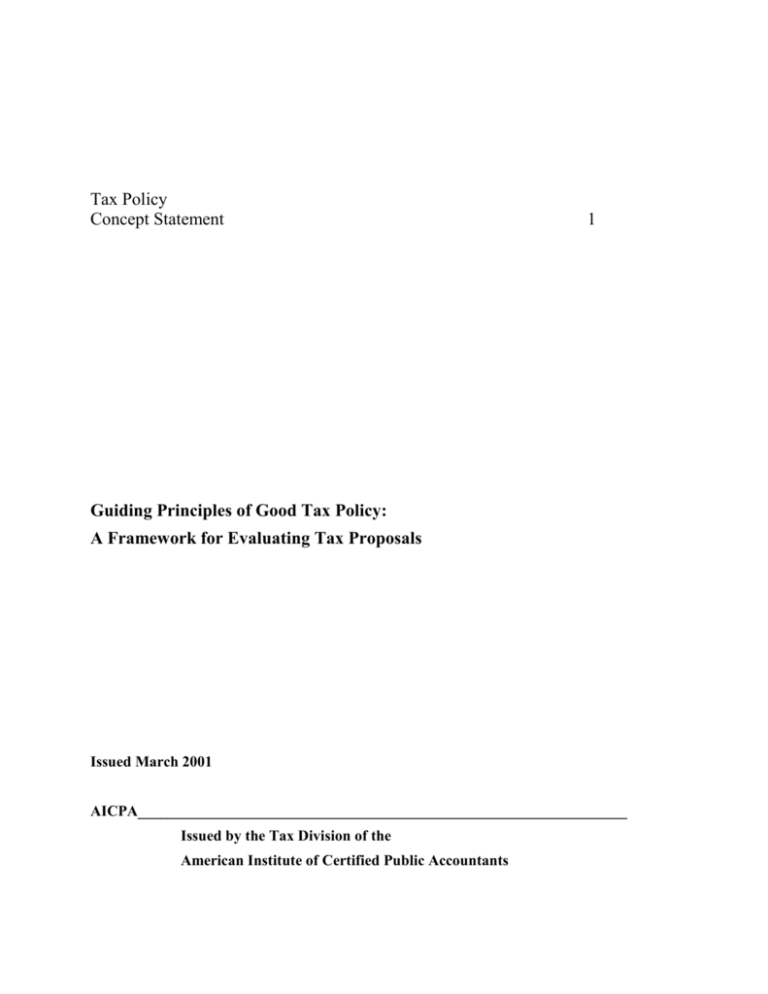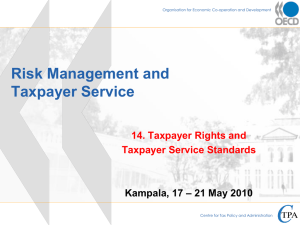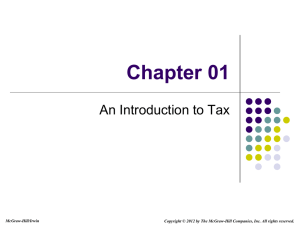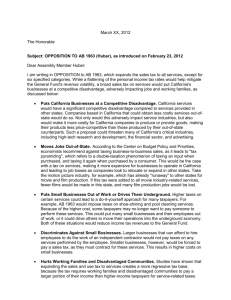
Tax Policy
Concept Statement
1
Guiding Principles of Good Tax Policy:
A Framework for Evaluating Tax Proposals
Issued March 2001
AICPA_________________________________________________________________
Issued by the Tax Division of the
American Institute of Certified Public Accountants
NOTICE TO READERS
Tax Policy Concept Statements of the AICPA Tax Division are issued for the general
information of those interested in the subject. They present the conclusions of the Division, as
approved by the Tax Executive Committee. The Tax Executive Committee is a senior technical
body of the AICPA authorized to speak for the AICPA in the area of federal income taxation.
Tax Policy Concept Statements are intended to aid in the development of federal tax legislation
in directions that the AICPA believes are in the public interest.
Tax Policy Concept Statements do not establish standards enforceable under the AICPA’s Code
of Professional Ethics and are not intended for that purpose.
2
Copyright © 2001 by
American Institute of Certified Public Accountants, Inc.
New York, NY 10036-8775
All rights reserved. For information about the procedure for requesting permission
to make copies of any part of this work, please call the AICPA Copyright Permissions
Hotline at 201-938-3245. A Permissions Request Form for e-mailing requests is
available at www.aicpa.org by clicking on the copyright notice of any page. Otherwise,
requests should be written and mailed to Permissions Department, AICPA,
Harborside Financial Center, 201 Plaza Three, Jersey City, NJ 07311-3881
1 2 3 4 5 6 7 8 9 0 TD 0 9 8 7 6 5 4 3 2 1
3
TABLE OF CONTENTS
Foreword
Overview
Purpose of This Tax Policy Concept Statement
The Ten Guiding Principles of Good Tax Policy
Explanations of the Ten Guiding Principles of Good Tax Policy
Equity and Fairness
Certainty
Convenience of Payment
Economy of Collection
Simplicity
Neutrality
Economic Growth and Efficiency
Transparency and Visibility
Minimum Tax Gap
Appropriate Government Revenues
Challenges
Conclusion
Bibliography
4
FOREWORD
This is the first in a series of tax policy concept statements issued by the AICPA Tax Division on
tax policy matters. It is intended to aid in the development of federal tax legislation in directions
that the AICPA believes are in the public interest.
Tax policy concept statements are approved by the Tax Executive Committee of the AICPA Tax
Division after they are developed and approved by the division’s Tax Legislation and Policy
Committee. Other division committees and technical resource panels may develop tax policy
concept statements if requested to do so.
This statement was developed by the Fundamental Tax Reform Task Force with input from the
1998-1999 Tax Policy and Simplification Committee and 1999-2000 Tax Legislation and Policy
Committee. It was approved by the 2000-01 Tax Legislation and Policy Committee and the
2000-01 Tax Executive Committee. Members of the bodies that approved this statement tax
policy concept statement are listed below.
AICPA Tax Executive Committee
(2000-01)
Pamela J. Pecarich, Chair
David A. Lifson, Immediate Past Chair
Ward M. Bukofsky
Stephen R. Corrick
Mark H. Ely
Anna C. Fowler
Jill Gansler
Robert L. Goldfarb
Kenneth H. Heller
Diane P. Herndon
Ronald S. Katch
Robert A. Petersen
Thomas J. Purcell, III
Jeffrey A. Porter
Jeffrey L. Raymon
Barry D. Roy
Jane T. Rubin
William A. Tate
Claude R. Wilson, Jr.
Robert A. Zarzar
AICPA Tax Legislation and Policy Committee
(2000-01)
Donald R. Longano, Chair
Michael L. Platner, Immediate Past Chair
Allen M. Beck
Rachelle B. Bernstein
Mark Garay
James (Rusty) Hale
Joseph L. Keller
Stuart Kessler
5
Anthony M. Komlyn
J.F. Kubik
Lorin D. Luchs
Phillip D. Moseley
Thomas P. Ochsenschlager
Judyth A. Swingen
Elizabeth Wagner
Additional Members
1999-2000 Tax Legislation and Policy Committee
1998-1999 Tax Policy and Simplification Committee
G. Fred Streuling, Vice-Chair/Chair (1998-2000)
Lawrence S. Albert (1998-1999)
Ralph A. Pastore (1998-2000)
F. Michael Dell (1998-1999)
William E. Philbrick (1998-1999)
Evan M. Liddiard (1999-2000)
Dennis (Pete) Rigby (1998-1999)
Annette Nellen (1998-2000)
C. Clinton Stretch (1998-1999)
Edmund Outslay (1998-1999)
Joseph F. Taricani (1998-1999)
AICPA Fundamental Tax Reform Task Force
Annette Nellen, Chair
James (Rusty) Hale
Edmund Outslay
J.F. Kubik
Dennis (Pete) Rigby
AICPA Tax Division Staff
Gerald W. Padwe, Vice President
Edward S. Karl, Director
William R. Stromsem, Director
Carol B. Ferguson, Technical Manager
The AICPA Tax Division gratefully acknowledges the significant contributions of Annette
Nellen in the development of the direction and the drafting of the statement.
6
Guiding Principles of Good Tax Policy:
A Framework for Evaluating Tax Proposals
OVERVIEW
Purpose of This Tax Policy Concept Statement
Every year, discussions take place among politicians, economists, tax practitioners, and others
about making changes to our federal and state tax systems. Some of the proposed changes are
fundamental in that they would, for example, replace the federal income tax with a consumption
tax. Other proposals call for varying degrees of change to the existing federal tax system, such as
adding or expanding tax incentives to encourage savings, modernizing the international tax rules
to better address today's global economy, or making procedural changes to improve compliance.
In addition, the emergence of electronic commerce (e-commerce) as a new way of doing business
has raised issues regarding the application of income, sales, and telecommunications taxes and
generated suggestions for reforming state and federal tax rules.
Any suggestion for modifying tax rules–whether major or minor—raises the question of how to
best analyze and compare proposals. Sponsors have reasons justifying their proposals, but
sometimes, the same reasons are offered for what appear to be vastly different proposals. For
example, the sponsors of both the flat tax and national retail sales tax state that the new system
would be simpler than the current income tax and would promote savings. Similarly, a frequently
cited beneficial feature of the flat tax is that it can be filed on a return the size of a postcard.
Nevertheless, even today's complex income tax system could be filed by all taxpayers on a
postcard-size tax return if no more than select elements of a taxpayer’s tax liability were
reported. The size of the tax return does not measure the complexity of the calculations that go
into each of the lines on the return. A framework based on appropriate tax policies is needed to
effectively analyze proposals to change tax rules and tax systems.
This statement provides a framework to help answer the question: How should proposals to
change existing tax rules be analyzed? This question is answered by providing ten principles,
listed in the following section, that are commonly cited and used as indicators of good tax policy.
The Ten Guiding Principles of Good Tax Policy
The AICPA recommends that this ten-principle framework be used to analyze proposals to change a tax
rule, as well as to change an entire tax system, such as by changing it from an income tax system to a
consumption tax system, or to better address e-commerce transactions. Note that the ten guiding
principles of good tax policy are equal in importance; the numbered order of the principles in this
statement is for reference only and should not be taken as an indication of the order of importance of
these principles.1
1. Equity and Fairness. Similarly situated taxpayers should be taxed similarly.
7
2. Certainty. The tax rules should clearly specify when the tax is to be paid, how it is to be
paid, and how the amount to be paid is to be determined.
3. Convenience of Payment. A tax should be due at a time or in a manner that is most likely
to be convenient for the taxpayer.
4. Economy in Collection. The costs to collect a tax should be kept to a minimum for both the
government and taxpayers.
5. Simplicity. The tax law should be simple so that taxpayers understand the rules and can
comply with them correctly and in a cost-efficient manner.
6. Neutrality. The effect of the tax law on a taxpayer’s decisions as to how to carry out a
particular transaction or whether to engage in a transaction should be kept to a minimum.
7. Economic Growth and Efficiency. The tax system should not impede or reduce the
productive capacity of the economy.
8. Transparency and Visibility. Taxpayers should know that a tax exists and how and when it
is imposed upon them and others.
9. Minimum Tax Gap. A tax should be structured to minimize noncompliance.
10. Appropriate Government Revenues. The tax system should enable the government to
determine how much tax revenue will likely be collected and when.
A more detailed explanation of each of the ten principles is provided in the next section of this
tax policy concept statement. This statement also notes some of the challenges that exist in
following the ten principles. Despite the challenges, however, proposals for changes to the tax
law should strive to incorporate all ten principles.
8
EXPLANATIONS OF THE TEN GUIDING PRINCIPLES
OF GOOD TAX POLICY
Equity and Fairness
Similarly situated taxpayers should be taxed similarly. The principle of taxing similar taxpayers
similarly is typically described in terms of equity. The concept of horizontal equity provides that
two taxpayers with equal abilities to pay should pay the same amount of tax. If a taxpayer has a
greater ability to pay than another taxpayer, the concept of vertical equity comes into play, which
means that the person with the greater ability to pay should pay more tax. Of course, how much
more tax should be paid has been a topic of debate under our current income tax system and, over
the decades, has resulted in a variety of ranges of graduated tax rates and exemption amounts
leading to varying levels of progressivity of the system.
The principle of equity is often viewed as a fairness principle. That is, many people view a tax as
fair if taxpayers with the greatest ability to pay have the highest tax burdens. Nevertheless, the
term fair tends to have different meanings to different people. For example, with respect to an
income tax, an income tax system might be considered fair if—
1. All taxpayers are taxed at the same tax rate (a flat tax) because those with higher incomes
will pay more than taxpayers with lower incomes.
2. Taxpayers with higher incomes pay tax at higher rates than lower income taxpayers (a
progressive tax).
3. Many different types of income are taxed the same (meaning, for instance, that few or no
types of income are excluded from taxation).
4. It combines the elements of items 1 and 3 above.
5. It combines the elements of items 2 and 3 above.
Therefore, use of the word fair in describing a tax might be better used in the context of whether
a tax system is perceived as fair. This approach acknowledges some of the subjectiveness of the
term fair.
Generally, in evaluating the principle of equity, consideration should be given to the entire range
of taxes a taxpayer is subject to, rather than to just one type of tax.
Certainty
The tax rules should specify when the tax is to be paid, how it is to be paid, and how the amount to be
paid is to be determined. A person's tax liability should be certain rather than ambiguous. The tax rules
should specify when the tax is to be paid, how it is to be paid, and the amount to be paid. A tax system’s
rules must enable taxpayers to determine what is subject to tax (the tax base) and at what tax rate(s).
Taxpayers should be able to determine their tax liabilities with reasonable certainty based on the nature
of their transactions. If the transactions subject to tax are easy to identify and value, the principle of
9
certainty is more likely to be attained. On the other hand, if the tax base is dependent on subjective
valuations or transactions that are difficult to categorize, the principle of certainty might not be attained.
In addition, how the taxes are paid and when the taxes are due should be spelled out in the applicable
laws, as well as in the tax forms and instructions.
Certainty is important to a tax system because it helps to improve compliance with the rules and
to increase respect for the system. Certainty generally comes from clear statutes as well as timely
and understandable administrative guidance that is readily available to taxpayers.
The principle of certainty is closely related to the principle of simplicity. The more complex the
tax rules and system, the greater likelihood that the certainty principle will be compromised.
Convenience of Payment
A tax should be due at a time or in a manner that is most likely to be convenient for the taxpayer. A tax
should be due at a time or in a manner that is most likely to be convenient for the taxpayer. A tax should
be payable when it is most likely to be convenient for the taxpayer. For example, a tax upon the
purchase of goods should be assessed at the time of purchase when the person still has the choice
as to whether or not to buy the goods and pay the tax. Convenience of payment is important in
helping to ensure compliance with the tax system. The more difficult a tax is to pay the more
likely that it will not be paid. Typical payment mechanisms include withholding (such as the
withholding of income taxes from employee paychecks) and periodic payments of estimated tax
liability. The appropriate payment mechanism should depend on the amount of the liability and
ease of collection.
Economy of Collection
The costs to collect a tax should be kept to a minimum for both the government and taxpayers. The costs
to collect a tax should be kept to a minimum. These costs include the administrative cost to the
government that is influenced by the number of revenue officers necessary to administer the tax. There
are also compliance costs incurred by taxpayers to consider. This principle is also closely related to the
principle of simplicity. The more complex a tax, the greater the costs for the government to administer it
and the greater the compliance costs for taxpayers to determine their tax liability and report it.
Simplicity
The tax law should be simple so that taxpayers understand the rules and can comply with them correctly
and in a cost-efficient manner. Simplicity in the tax system is important both to taxpayers and to those
who administer the various taxes. Complex rules lead to errors and disrespect for the system that can
reduce compliance. Simplicity is important both to improve the compliance process and to enable
taxpayers to better understand the tax consequences of transactions in which they engage in or plan to
engage.
Neutrality
The effect of the tax law on a taxpayer’s decisions as to how to carry out a particular transaction or
whether to engage in a transaction should be kept to a minimum. The effect of the tax law on business
and personal decisions should be kept to a minimum. That is, taxpayers should not be unduly encouraged
or discouraged from engaging in certain activities or taking certain courses of action primarily due to the
10
effect of the tax law on the activity or action. The primary purpose of a tax is to raise revenue for
governmental activities, rather than to influence business and personal decisions.
Economic Growth and Efficiency
The tax system should not impede or reduce the productive capacity of the economy. The tax system
should neither discourage nor hinder national economic goals, such as economic growth, capital
formation, and international competitiveness. The principle of economic growth and efficiency is
achieved by a tax system that is aligned with the economic principles and goals of the jurisdiction
imposing the tax. For example, U.S. tax rules should not pose competitive disadvantages for U.S. firms
relative to foreign firms. Economic growth and efficiency is impeded by tax rules that favor a particular
industry or investment thereby causing capital and labor to flow to such areas for reasons not supported
by economic factors which can potentially harm other industries and investments, as well as the economy
as a whole.
The principle of economic growth and efficiency is related to the principle of neutrality in that
tax rules that distort taxpayer behavior may hinder economic efficiency.
Transparency and Visibility
Taxpayers should know that a tax exists and how and when it is imposed upon them and others. Visibility
enables individuals and businesses to know the true cost of transactions. It also enables them to see what
their total tax liability is and to which level of government it is being paid. When a tax is not visible, it
can be easily retained or raised with little, if any, awareness among taxpayers about how the tax affects
them.
Minimum Tax Gap
A tax should be structured to minimize noncompliance. The tax gap is the difference between taxes
that are owed and taxes that are voluntarily paid. A tax gap exists with any tax for a variety of reasons,
such as intentional errors (non-filing, underreporting of income, overstating of deductions, omission of
transactions) and unintentional errors (math mistakes and lack of understanding of the rules). A number
of tax provisions may encourage noncompliance because the provision is too complex to understand or to
comply with. Procedural rules are generally required for all tax systems in order to encourage
compliance. Rules to encourage compliance might include mandatory withholding of taxes at the source
and penalties for noncompliance. Generally, compliance measures need to strike a balance between the
desired level of compliance against the costs of enforcement and the level of intrusiveness of the tax
system.2
Appropriate Government Revenues
The tax system should enable the government to determine how much tax revenue will likely be
collected and when. Tax systems should have some level of predictability and reliability to
enable the government to determine how much tax revenue is likely be collected and when. This
is particularly important to state governments, most of which operate under a balanced budget
requirement. Typically, a mix of taxes provides a more stable tax base because different types of
taxes are affected differently by changes in the economy.
11
Governments need some assurance that tax revenues will be stable so that required spending can
occur. For example, in an economic downturn causing unemployment, income tax revenues will
decline. If the government is collecting other types of taxes that are less affected by decreased
employment or the effect will not occur as quickly, government revenues in total will be less
adversely affected than if the government relied solely on an income tax.
12
CHALLENGES
Various challenges exist to incorporating the ten guiding principles of good tax policy into our
federal and state tax systems. A number of these challenges stem from the desire to use the tax
law for more than raising revenue, for instance, to implement social or economic policies (such
as by limiting certain deductions and credits to individuals with income below specified
amounts). In addition, frequent changes to the tax law challenge the principles of certainty and
simplicity. The more changes that are made, the greater the difficulty taxpayers, practitioners,
and government tax administrators have in understanding the tax consequences of transactions.
Also, it becomes more difficult for the Internal Revenue Service (IRS) and state tax agencies to
issue guidance in a timely manner when there are hundreds of tax law changes every few years.
The frequency of changes to the federal tax law has become overwhelming as described by the
IRS National Taxpayer Advocate:
“In TRA 86, Congress made approximately 1,850 separate amendments to the Internal Revenue
Code. … Since TRA 86 and ending in 1998, Congress made approximately 6,500 changes to Title
26 in 61 different pieces of legislation. In fact, the Taxpayer Relief Act of 1997 and RRA 98 alone
made 1,260 changes to the tax code. The magnitude of the changes made by those two pieces of
legislation resulted in revisions of at least 100 separate IRS forms.”3
A key challenge is the reality that not all ten of the principles can always be achieved to the same
degree for all proposed tax changes. For example, to exclude a particular type of economic
benefit from taxation may satisfy the simplicity principle, but not the equity or neutrality
principles. Thus, lawmakers must carefully balance the ten principles to achieve an optimal law.
CONCLUSION
A framework of appropriate tax principles is needed to analyze proposals to change tax rules and
tax systems in order to best ensure an effective tax system based on good tax policy. The
challenges that exist to incorporating the ten guiding principles of good tax policy are not
insurmountable. It will take a concerted effort though, to consider these ten principles in any type
of tax law change – both major and minor.
The AICPA encourages policymakers to work to improve our tax systems to better incorporate
the principles outlined in this tax policy concept statement and will continue to offer its
assistance in this important endeavor.
1
One framework that is frequently used to define good tax policy was laid out by economist Adam Smith in his 1776
work entitled The Wealth of Nations. (See The Wealth of Nations, edited by Edwin Cannan, New York, The
Modern Library, 1994, pages 887 to 890). A review of tax systems at each level of government today shows the
influence of Adam Smith's maxims of tax policy. The first four principles provided in this report are based on
Smith’s maxims. The remaining six principles have originated with state and federal legislators and administrators,
as well as tax advisers and economists. The latter, more modern principles are considered an appropriate basis for
good tax policy and are often used to justify changes to the tax laws. For example, see Joint Committee on
Taxation, Description and Analysis of Proposals to Replace the Federal Income Tax (JCS-18-95), June 5, 1995,
pages 58 to 59.
13
2
General Accounting Office (GAO), Reducing the Tax Gap – Results of a GAO-Sponsored Symposium, June 1995,
GAO/GGD-95-157, page 13.
3
Statement of the National Taxpayer Advocate in testimony before the Subcommittee on Oversight of the House
Committee on Ways and Means, May 25, 1999.
14
BIBLIOGRAPHY
AICPA, Blueprint for Tax Simplification, April 1992.
Department of Treasury, Tax Reform for Fairness, Simplicity, and Economic Growth, Volume 1,
November 1984.
Foundation for State Legislatures and National Conference of State Legislatures, Principles of a
High-Quality State Revenue System, Second Edition, November 1992; reprinted in Is the New
Global Economy Leaving State-Local Tax Structures Behind? published by the NLC, NCSL
and NGA, 1998, page 67.
General Accounting Office (GAO), Reducing the Tax Gap – Results of a GAO-Sponsored
Symposium, June 1995, GAO/GGD-95-157.
Joint Committee on Taxation, Description and Analysis of Proposals to Replace the Federal
Income Tax (JCS-18-95), June 5, 1995.






